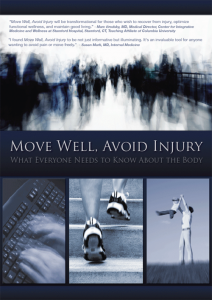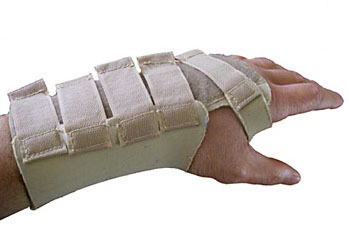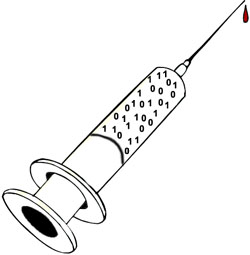The changes keep happening this month. Hot on the heels of the release of our new RSI FAQ page, we have decided to change the site with a new revamped look and feel. Hopefully you all like it. Its a great advantage being married to someone who does web development for a living and who doesn’t have RSI!
Category: Miscellaneous
I have recently had a surgical procedure to release a bad trigger finger condition on the middle finger of my right hand which I previously discussed in my post titled ‘Trigger Finger and RSI?‘. The problem is also accurately summarised with diagrams on this page about trigger finger.
Trigger finger is where a finger in a gripping position appears to lock in place. When you pull the finger open, it unlocks with a click (or in my case a loud ‘clunk’ which made anyone around me squirm!), hence the name trigger finger. The condition is caused by a nodule growth on the tendon which gets stuck on the pulley (sheath) system that is there to guide/hold the tendon in place. Doctors have minimal knowledge about why this nodule forms. Nodules on tendons can come and go on their own, but this one has been bad and persistent.
The build up to the operation had certainly been playing on my mind for several months. Unsurprisingly the mental prospect of the surgery was the worst part since the operation itself was only 15min in duration and was carried out under local anaesthetic (although I avoided the temptation to watch it!).
The procedure itself involved cutting open the sheath(pulley) that was causing the tendon restriction to occur, which freed the movement of the tendon (and nodule). The surgical entry point was on the palm of the hand just below the finger, and the incision itself was only about 1 inch long.
Recovery time has been fast. I am now nearly 3 weeks post op, the stitches are out , and the skin on the scar has fully healed over. I still have joint stiffness, and a bit of swelling which causes my finger to stiffen up in the bent position, but I expect this to gradually subside over time, especially after I keep stretching it like I have been instructed to do by the physiotherapists.
It is too early to do a complete assessment of the experience, but I can say that it’s great not having an annoying triggering finger condition any longer!
I wish there was a simple solution like this to my RSI condition!
UPDATE : 1 month post op
It’s now been about 1 month post operation, and I thought I’d update this post. Although the scar on the plam of the hand is healed over, however I still have a lot of sensitivity about the entrance wound, as well as a lump under the wound. Not sure at this point if the lump is scar tissue or the nodule. The triggering has gone, but I still have a lot of stiffness in the joint, and the finger still likes to stick in the bent position (I have to physically bend it straight with my other hand). Hopefully this is just a result of the swelling and that this will go away on time. I am using the finger, but it can be sore depending on the task at hand.
Update: 2 1/2 months post op
The finger is getting better all the time. It doesn’t stiffen up as frequently as before, but it still can stiffen quite badly and there is no cause I can determine for this. I recently had a follow up with the surgeon, and was advised that post op stiffness is common, and recovery can be as much as 18 months for some individuals – they don’t tell you that before the op! He suggested massaging the joint to reduce the swelling. The scar has totally healed up now, and is a whole lot less sensitive than it was a few weeks ago.
Update: 6 months post op
It’s certainly taken it’s time, but the finger is showing very little stiffness now. I can extend it fully contract it fully, grip things tightly, and have no sign of that horrible triggering any more. I can officially say the op was a success. It does go to show that there is a 3-6 month recovery term for this operation. Good luck with the operation if you are someone who is considering having it done and just factor in a few months for the recovery.
Rate this post! [ratings]
DVD : Move Well Avoid Injury : What everyone needs to know about the body (by Barbara Conable and Amy Likar, Andover Productions, 2009)
 I may not be a medical professional, but I am able to tell when I encounter descriptions of body motion that just make plain sense, and this DVD contains some enlightening information. In a collection of well narrated chapters complete with diagrammatic video illustration, the evidence is laid bare of our common tendencies to keep our bodies out of balance, causing pain through muscle tensions that, in turn, keep our bodies in bad posture. This is due in part to us having mapped the body in a particular way, eg in relation to position, when in reality the position is entirely different.
I may not be a medical professional, but I am able to tell when I encounter descriptions of body motion that just make plain sense, and this DVD contains some enlightening information. In a collection of well narrated chapters complete with diagrammatic video illustration, the evidence is laid bare of our common tendencies to keep our bodies out of balance, causing pain through muscle tensions that, in turn, keep our bodies in bad posture. This is due in part to us having mapped the body in a particular way, eg in relation to position, when in reality the position is entirely different.
This DVD is broken into multiple sections covering the many aspects of posture imbalance, and covers areas from the head to the feet and just about everywhere in between. Posture is translated by the authors as ‘Body Maps’ which are essentially memories in your mind of where you think your individual body parts are and how you use them. The DVD highlights how you may have had a flawed map (understanding) of your various body parts in your mind from a very young age. This may have led you to actually move according to those flaws and results in the straining of some parts of your body which can lead to pain. As the narrator tells us, “We move in the way in which we think we are constructed …”, either consciously or unconsciously. Wrong body maps can be responsible for many bad posture related problems, from walking to sitting, to using a computer.
Subjects covered in the DVD include –
- Body maps – identifying flaws in the human body map and how to recognise those errors
- Balance – identifying correct balance with core posture, and identifying posture related pain
- Kinesthesia – learning free and fluid movement to correct body imbalances
- Arms – covering shoulders, elbows, wrists and hands
- Legs – covering hips, pelvis, knees and feet
- Breathing – covering lungs, skeletal/muscular system, diaphragm
- Mapping the whole body
- Correcting the map
- Inclusive attention
The areas I can relate to most pertain to the shoulders, arms, wrists and hands. These are covered in detail and are very applicable to the RSI sufferer. The main posture/skeletal issues with RSI type injuries are listed, adding to the viewer’s knowledge and understanding through plain and straightforward explanations along with clear diagrams and video.
From previous experience, I knew that over-supination of the wrists was a bad thing, but now I know about the natural axis of rotation of the forearm and how it ties in with a neutral position wrist, as well as why supination causes so many injuries.
The company website rather generously shows sample videos of some chapters which are well worth checking out, and will give you a sneak peak of the DVD content and style as well as some key body map information!
- ‘Elbows’ chapter
- ‘Arms’ chapter
- ‘Forearms’ chapter
- ‘Hands’ chapter
- ‘Lower Back’ chapter
- ‘Balance’ chapter
- ‘Lungs’ chapter
I also found the section on breathing very interesting. It’s probably the first time I’ve been able to picture the role of the diaphragm in breathing, and I certainly had my lungs mapped as being a bit lower than they actually are. The related section on the ribcage was also revealing to me having just recently strained my sternum connective tissue whilst gardening. It also reinforces the benefits of some breathing practices including Yogic breathing (Pranayama).
The DVD run time is a substantial 2hrs, and certainly lends itself to being watched in stages. There is the temptation to skip straight to the section you are most interested in, however it should be watched as a whole to get the complete picture and overall message firmly ingrained in your mind. I expect that multiple viewings would be best to fully absorb the detail.
All in all this DVD is an excellent resource for just about everyone. It is not solely aimed at one specific group of people eg RSI sufferers, but covers the whole body, and should be a useful education tool for everyone, including ergonomists, physiotherapists, fitness instructors, yoga teachers etc, as well as many others including in the medical profession.
If you have posture related pain it’s likely that it’s down to your bad body map and it’s certainly time to re-educate yourself!
Rate this post! [ratings]
 I’ve been through a fair share of wrist braces in my time with RSI. Wrist braces are often the first item you will obtain after seeing a physical therapist about an RSI condition. They can be a lot of help to a RSI sufferer, but have to be used correctly, comfortably, and should not be used if they worsen your RSI symptoms.
I’ve been through a fair share of wrist braces in my time with RSI. Wrist braces are often the first item you will obtain after seeing a physical therapist about an RSI condition. They can be a lot of help to a RSI sufferer, but have to be used correctly, comfortably, and should not be used if they worsen your RSI symptoms.
There are a lot of braces out there, and what works for one person may not work for everyone. Braces are usually made out of neoprene or elasticated material coupled with a metal or hard plastic support to immobilise the wrist.
The primary use of the wrist brace should not be forgotten ie to rest wrist joints and forearm muscles that drive the wrist motion (forearm extensors, flexors), and reduce the pain associated from overuse injuries. While this may sound like a good thing, quite often if you wear a brace while using a computer, you will end up using other muscles in a strenuous way to do the same work, and can cause other injuries because of this.
There is no such thing as an ideal wrist brace, it really depends on what they are trying to do.
In the course of your RSI journey you way well encounter many different styles of wrist braces.
My general rules concerning wrist braces are –
- You shouldn’t jump in and buy a wrist brace without first seeking advice from a physiotherapist or doctor.
- Ideally, it should be used to rest (heal) the wrist and the overused (painful) muscles that drive the wrist extension and flexion, and not worn when using a keyboard or mouse.
- Exceptions to the rule are perhaps specific braces intended to stop excessive flexion of the wrist if you are prone to this. It’s a far better idea to be able to spot this flexion yourself and change it, but if you have difficulty doing this then a brace may be required. Alternatively have someone stand and watch over you with a big stick, you will learn faster then!
- Braces used to rest the wrist should not be too tight, just a snug fit. Over tightening can lead to restricted blood flow to the hand and wrists.
- Consider wearing a wrist brace at night in bed to avoid sleeping with your arms/wrists/hands in bent positions. It is critical that you don’t have a tight brace when doing this so as not to restrict blood flow.
- Don’t use them unless you have to. Its better to know your pain, when it happens and try to make adjustments to your work practice etc to reduce the causes than it is to just ‘bandage up’ your injured wrists into a brace.
- Neoprene braces can be hot, sweaty, smelly and itchy to wear even for short periods of time. Better to look for ventilated elastic material ones.
- Wrist braces are not a good universal fit for everyone, so you may have to make some adjustments to it to make it comfortable, including cutting bits out of it or adding some customised padding.
- Wear them at work and they do flag to your employer and colleagues that you have a RSI problem!
Remember though, wrist braces are not a solution to RSI, they are really only there to rest an injury and ease pain. To address your injury it is far better to try to make adjustments to your work to stop the motion that is causing you to have the pain. In other words, you should monitor your wrist, hand motions at a keyboard etc, and make adjustments to your bad working practices, including posture changes. You should also introduce more regular breaks away from your computer along with a good stretching routine and some physical activity.
Rate this post! [ratings]
Trigger Finger and RSI?
I’ve just been dealing with a bad case of trigger finger – a condition where a finger becomes locked in a gripped position.
It’s happening (quite badly) on the middle finger of my right hand – so much so that I have to use my other hand to prise the stuck finger open again! I also have minor trigger symptoms on some of my other fingers. It’s not just an inconvenient condition, it can be quite painful too! Usually trigger finger cases can clear up with some rest, ice and anti-inflammatory medication but this one has been with me for quite some time.
The trigger condition has been diagnosed as such by doctors, and has been treated twice with steroidal injections (to no avail). Surgery looks like the next option for me to relieve this condition, and is only a day patient procedure done under
Addicted to Technology
 We are a species that spends most of our lives battling addictions of one sort or another – ranging from what we consume to television to news, the list is endless. Our addiction to technology is no different. The cool technological gadgets that adorn our lives are just so addictive!
We are a species that spends most of our lives battling addictions of one sort or another – ranging from what we consume to television to news, the list is endless. Our addiction to technology is no different. The cool technological gadgets that adorn our lives are just so addictive!
There are so many ways today to fritter away huge amounts of our time in our new virtual worlds. Have you ever played a video game and noticed how 3 hours of your life just disappeared?
Technology has brought us immense benefits as a society, but it has also made us slaves to a great extent, and we spend ever increasing amounts of time interacting with devices whether they be computers, mobile phones, PDAs, games consoles, MP3 players, GPS or TV remotes.
A substantial portion of employment now involves working on computers, whether it be the inputting/analysing of data, or the creation of the latest software that controls our lives. The trouble is that, the more high technology we introduce to our lives, the more time we spend interacting with it, often to the disadvantage of our health. It’s not too hard to imagine that, if current trends continue, there will be a technological gadget to interact with from the moment we wake up until the moment we fall asleep (or more scarily from the moment we are born until the moment we die!).
The Web has expanded the information available at our fingertips by a staggering amount. It has also changed
Yoga as a tool to combat RSI
 During my RSI awareness presentations I refer to the need for people at risk of RSI as well as those who already experience its effects to adopt physical activities. Yoga is one of those activities that I suggest. Why yoga?
During my RSI awareness presentations I refer to the need for people at risk of RSI as well as those who already experience its effects to adopt physical activities. Yoga is one of those activities that I suggest. Why yoga?
In a nutshell, it combines a fairly physical activity encompassing muscle and tendon stretches from your head to your toes, with core conditioning and balance practices. This is coupled with controlled breathing techniques to allow the participant to focus their mind on the present moment. As well as the physical practice, yoga teaches techniques to promote deep relaxation and the ability to clear everyday thoughts from the mind with meditation. This powerful combination really can address a lot of the factors that lead to conditions like RSI (primarily driven by the overused micro-movements of muscles and tendons coupled with bad ergonomics and stressful working conditions).
A typical RSI sufferer’s day
 Some readers may not know what it’s like to suffer from a computer related RSI (repetitive strain injury). The following provides a small glimpse into my previous life on a typical day at the office in a full time well paid job with a continual workload.
Some readers may not know what it’s like to suffer from a computer related RSI (repetitive strain injury). The following provides a small glimpse into my previous life on a typical day at the office in a full time well paid job with a continual workload.
My typical RSI day
7.00am wake up. RSI pain feels best right now having had a good sleep. May feel even better if I have remembered to wear my wrist brace over night. If I haven’t, then I may have tingling/pain and numbness in the hands and wrists before the day starts – not good! (stress level 0/10, pain level 1/10)
8.30am put wrist brace on to drive in traffic to job. Between busy driving conditions and thoughts of workload ahead, I’m starting to feel less relaxed. Arrive at work, on time, but a bit stressed after all that traffic! (stress level 2/10, pain level 2/10)
10.00am spent 1hr catching up on overnight emails, creating actions from them and replying to others (stress level 4/10, pain level 5/10)
11.00am spent most of mid morning working on latest priority work (maybe if I get this out of the way now, I’ll get to my real work this afternoon). Pretty absorbed in work, trying to
RSI and Job Performance
Performance v Endurance
If you are anything like I was, you are a good conscientious performer in your job. You may have been working extra hours to make sure you did a good job, you may also have worked evenings, weekends and even holidays. This is more often than not done to meet or exceed your goals, improve your chances of promotion and attain the related pay increases. It’s quite often the people who work hardest who are the most stressed in life, because they care about the quality of their work. They may often be the ones carrying the biggest workload, mainly because they are performing the best. This high pressure work may all be being conducted on a computer and therefore exposing the worker to some of the greatest risk factors for an onset of an RSI.
It would be interesting to do a poll of RSI sufferers in the industry and see how many correlated to previously ‘good’ performing employees, although reliable data may be very hard to obtain.
It’s an old cliche, but in your job you have to try to strike a good balance between
Text Messaging RSI Timebomb
 Just came across an old article on mobile phone texting and RSI from 2006. In the article it states that almost 4 million people in the UK are suffering from Repetitive Strain Injuries relating to using their mobile phones for texting.
Just came across an old article on mobile phone texting and RSI from 2006. In the article it states that almost 4 million people in the UK are suffering from Repetitive Strain Injuries relating to using their mobile phones for texting.
The UK has a high rate of mobile phone use for texting (we are a nation of texting addicts!), and it is highly prevalent in the under 20 age group. Texting of course is the act of creating a text message on a small mobile device, with either a standard numeric phone pad with alphabetical letters encoded in the pad or a full mini sized keypad with a key for each letter/character. Irrespective of the key count that these small devices have, they all have something in common and that is very small repetitive motion of the fingers and mainly thumbs, in a very confined location.
I first encountered such a device in 2001 when I had my first text messaging pager with tiny full keypad. As an RSI sufferer back then, I was interested to see how it felt to use. Of course being a thumb typing device, it was easier for me to